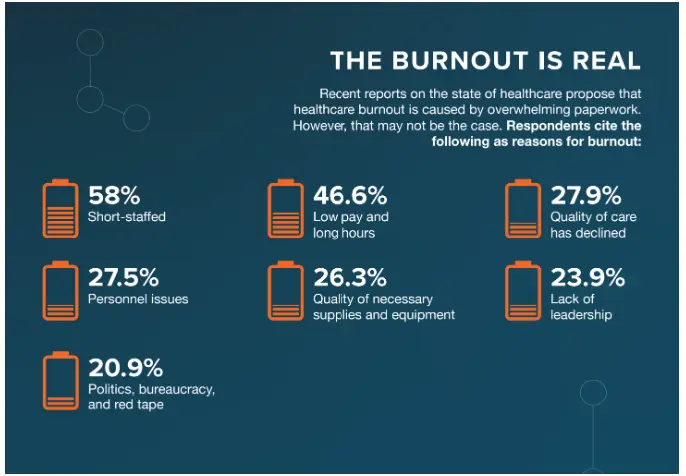

July 22, 2024 - by Synoptek
“We don’t have enough doctors,” says a CNN report. The healthcare workforce shortage is a serious concern among US lawmakers. A disturbing report suggests that the United States is in acute need of 17,000+ primary healthcare practitioners, 12,000+ dental caregivers, and 8,200+ mental health professionals.
Not just that, globally, the healthcare industry is facing a significant challenge in the form of future labor shortages. Nipping this issue in the bud requires a multifaceted approach and a comprehensive understanding of the contributing factors. This blog will delve into the key factors driving labor shortages and explore strategies to mitigate their impact.
Demographic changes signify an aging population that requires more medical attention, and healthcare workers are retiring faster than they are being replaced. Burnout, high workload, lack of qualified faculty, rise in chronic conditions, low compensation, and high job demands collectively contribute to the healthcare labor shortages. Here are four factors that expedite healthcare labor shortages:
Since the pandemic, the number of healthcare professionals leaving their jobs has significantly increased. For instance, approximately 900,000 nurses are projected to exit the industry in the US from 2020 to 2027. This exodus is attributed to factors such as stress, burnout, and the desire for more fulfilling work. Similarly, two out of three physicians express experiencing burnout, which further worsens the problem.

Source: HIT Consultant
The aging population will significantly increase the demand for healthcare services. The number of Americans aged 65 and older is projected to rise from 58 million to 82 million by 2050. This demographic shift will require the healthcare industry to adapt and find ways to care for an aging population effectively and efficiently.
Palliative care is also expected to grow. It will raise the need for specialized medical care for people with serious illnesses, focusing on symptom relief and improving quality of life.
Isolation, untreated substance abuse, difficulties in accessing care, and interruptions in harm reduction programs are leading to a rise in mental health issues. Statistics say that Americans from all sections of society are reporting distress and mental health concerns. About 21% of adults are going through at least one mental illness, making it approximately 50 million people.
One in five adults is seeking treatment for mental health issues, and the Department of Health and Human Services has implemented programs to address this need. Healthcare providers must be equipped to address physical and mental healthcare needs simultaneously.
Disjointed technology systems that do not communicate effectively often result in longer wait times, delayed care, and an overall poorer patient experience. When healthcare technologies are not well integrated, clinicians are forced to deal with inefficient workflows, duplicated efforts, and manual administrative tasks. Increased workload and lack of streamlined processes easily contribute to burnout levels, causing healthcare workers to quit.
A Southern California-based behavioral health agency working on child and family welfare needed an integrated data platform with a centralized reporting to eliminate manual data preparations and get actionable insights role wise. Read how a data warehouse platform helped evolve operations and provide timely and reliable care to patients.
|
Utilizing technology to improve clinical workflows and implementing strategies to retain current staff and prevent burnout can help healthcare workers focus more on direct patient care. Additionally, implementing a multi-pronged approach comprising technology, retention, rehiring, and recruitment can help fight staffing shortages.
Investing in technology that streamlines processes and integrates data can significantly reduce the workload of healthcare professionals. For example, implementing data warehouses and business intelligence tools can provide actionable insights and improve productivity. It can be achieved through platforms integrating various data sources, such as electronic health records (EHRs) and human resources management systems (HRMS).
Addressing burnout and improving work-life balance can be achieved by implementing stress-reducing measures, such as flexible work arrangements and mental health support programs. Incentivizing healthcare staff for high performance and recognizing their efforts go a long way in retaining the right talent.
It is crucial for healthcare professionals to quickly upskill and reskill to adapt to new technologies and roles smoothly. It will be achieved through training programs focusing on data analysis, technology integration, and patient care. Necessary skills and experience ensure preparedness to address the challenges of the future.
Encouraging a data-driven culture within healthcare organizations can help make informed decisions and improve operational efficiency. Consider leveraging intuitive visualization tools and dashboards that enable healthcare professionals to access and analyze data quickly, easily, and accurately. Such tools can help in reducing manual reporting and improving compliance rates.
Partnering with a managed services provider (MSP) is a great way for healthcare organizations to overcome staffing shortages and burnout and easily navigate complex issues.
MSPs can take on the burden of managing IT operations, security, cloud hosting, and other critical functions, allowing internal teams to focus on delivering high-quality patient care. By leveraging specialized expertise and experience, healthcare organizations can reduce costs, improve efficiency, and free up resources to focus on work that saves lives. Ultimately, healthcare managed services can strengthen the organization’s resilience and adaptability, ensuring it is prepared to meet the evolving needs of patient care—both now and in the future.